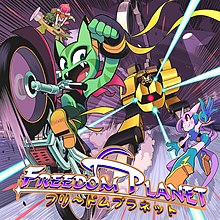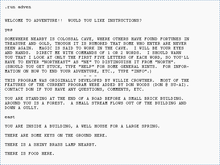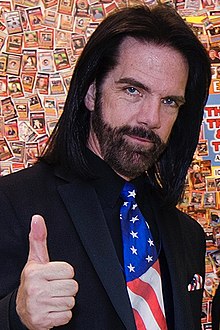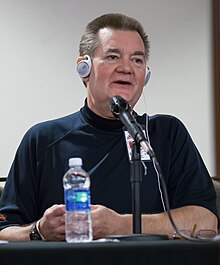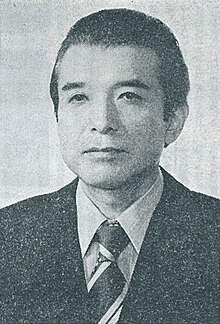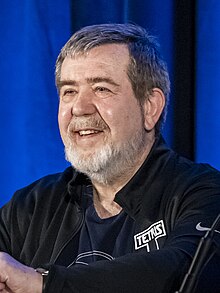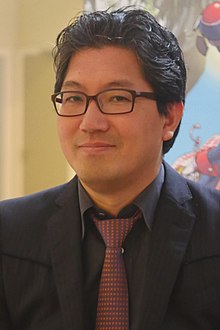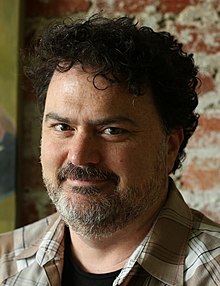The Video Games Portal

A video game, also known as a computer game or just a game, is an electronic game that involves interaction with a user interface or input device (such as a joystick, controller, keyboard, or motion sensing device) to generate visual feedback from a display device, most commonly shown in a video format on a television set, computer monitor, flat-panel display or touchscreen on handheld devices, or a virtual reality headset. Most modern video games are audiovisual, with audio complement delivered through speakers or headphones, and sometimes also with other types of sensory feedback (e.g., haptic technology that provides tactile sensations). Some video games also allow microphone and webcam inputs for in-game chatting and livestreaming.
Video games are typically categorized according to their hardware platform, which traditionally includes arcade video games, console games, and computer (PC) games; the latter also encompasses LAN games, online games, and browser games. More recently, the video game industry has expanded onto mobile gaming through mobile devices (such as smartphones and tablet computers), virtual and augmented reality systems, and remote cloud gaming. Video games are also classified into a wide range of genres based on their style of gameplay and target audience. (Full article...)
Featured articles –
Development of The Last of Us began in 2009, soon after the release of Naughty Dog's previous game, Uncharted 2: Among Thieves. For the first time in the company's history, Naughty Dog split into two teams; while one team developed Uncharted 3: Drake's Deception, the other half developed The Last of Us. The relationship between Joel and Ellie became the focus, with all other elements developed around it. Actors Troy Baker and Ashley Johnson portrayed Joel and Ellie, respectively, through voice and motion capture, and assisted creative director Neil Druckmann with the development of the characters and story. The original score was composed and performed by Gustavo Santaolalla.
Following its announcement in December 2011, The Last of Us was widely anticipated. It was released for the PlayStation 3 in June 2013. It received acclaim for its narrative, gameplay, visuals, sound design, score, characterization, and female characters. The Last of Us became one of the best-selling video games, selling over 1.3 million units in its first week and 17 million by April 2018. The game won year-end accolades, including Game of the Year awards from several gaming publications, critics, and awards ceremonies. It has been ranked as one of the greatest video games ever made. (Full article...)
For the next game in the Halo trilogy, O'Donnell added new themes as well as bringing back and expanding old ones, some of which had never been recorded with a full orchestra before. The score made extensive use of the piano, an instrument which O'Donnell used frequently for composition but that had not been featured in previous Halo music. In addition to scoring the game, the music was used for promotional advertisements and trailers preceding Halo 3's release. The game's score and its soundtrack were generally well received. The soundtrack reached the Billboard 200 chart, and also broke the top twenty best-selling soundtracks and independent albums listings. The score was nominated for X-Play's "Best of 2007" awards, under best original soundtrack. (Full article...)
In designing the game, Cerny drew inspiration from miniature golf, racing games, and artwork by M. C. Escher. He aimed to create a game that offered a distinct experience with a unique control system. Cerny applied a minimalist approach in designing the appearance of the game's courses and enemies. Throughout development, he was frequently impeded by limitations in technology and had to forgo several design ideas.
Upon its release in arcades, Marble Madness was commercially successful and profitable. Critics praised the game's difficulty, unique visual design, and stereo soundtrack. The game was ported to numerous platforms and inspired the development of other games. A sequel was developed and planned for release in 1991, but it was canceled when location testing showed the game could not succeed in competition with other titles. (Full article...)
Freedom Planet is a 2014 platform game developed and published by American video game designer Steven DiDuro, for his studio GalaxyTrail. The player controls one of three anthropomorphic animal protagonists: the dragon girl Lilac, the wildcat Carol, or the basset hound Milla. Aided by a duck-like alien named Torque, the girls attempt to defeat the evil Lord Brevon, who plans to steal the Kingdom Stone and conquer the galaxy. While the game focuses on fast-paced platforming, its levels are interspersed with slower action scenes.
DiDuro first began developing Freedom Planet as a Sonic the Hedgehog fangame using characters created by DeviantArt user Ziyo Ling for its main cast. Early into development, she lost interest in creating a derivative work and reconceived the project as her own intellectual property. Sash Lilac, originally a hedgehog, became a dragon; antagonist Doctor Eggman was replaced by Lord Brevon with his eyebrows resembling Doctor Eggman's mustache; and the Sonic series' ring-based health system was abandoned. Further changes were suggested by fans and incorporated throughout development. Freedom Planet was developed in Denmark and the United States, with its art direction carrying East Asian influences, such as medieval Chinese art inspiring its background visuals.
With development focused on the Windows platform, the game started out as a demo first released in August 2012 and was, after a successful Kickstarter campaign, released in its entirety via Steam in July 2014. Freedom Planet was later released for the Wii U in October 2015, for the PlayStation 4 in 2017, and for the Nintendo Switch in August 2018. The game received largely positive reviews; critics praised its gameplay, visuals, music, aesthetics, sense of humor and balance of Sonic elements with original content, but were mixed on its pacing, voice acting, story and the abundance of long cutscenes. (Full article...)
Nuts & Bolts entered production following the completion of Grabbed by the Ghoulies (2003) and was developed by the same team behind the Nintendo 64 Banjo games, led by designer Gregg Mayles. It began as a remake of Banjo-Kazooie (1998) but was repurposed as an original game. Rare sought a broad audience and, wanting to evolve the platform genre, introduced vehicular gameplay to take advantage of the Havok physics engine. The customisation elements originated from the Rare co-founder Tim Stamper's suggestion for a game similar to connecting Lego bricks. The soundtrack was composed by Robin Beanland, Dave Clynick, and Grant Kirkhope in his final work for Rare.
Nuts & Bolts was released in November 2008. It drew criticism from fans for departing from the Banjo-Kazooie gameplay, but received generally positive reviews. Critics considered the vehicle editor robust and praised the visuals, music, and creativity, though they found some challenges tedious, and some questioned the new direction. Nuts & Bolts was a commercial disappointment, selling 140,000 copies in the United States by the end of 2008. Afterwards, Microsoft laid off staff at Rare and restructured them as a Kinect and Avatar-focused developer. (Full article...)
Colossal Cave Adventure (also known as Adventure or ADVENT) is a text-based adventure game, released in 1976 by developer Will Crowther for the PDP-10 mainframe computer. It was expanded upon in 1977 by Don Woods. In the game, the player explores a cave system rumored to be filled with treasure and gold. The game is composed of dozens of locations, and the player moves between these locations and interacts with objects in them by typing one- or two-word commands which are interpreted by the game's natural language input system. The program acts as a narrator, describing the player's location and the results of the player's attempted actions. It is the first well-known example of interactive fiction, as well as the first well-known adventure game, for which it was also the namesake.
The original game, written in 1975 and 1976, was based on Crowther's maps and experiences caving in Mammoth Cave in Kentucky, the longest cave system in the world; further, it was intended, in part, to be accessible to non-technical players, such as his two daughters. Woods's version expanded the game in size and increased the number of fantasy elements present in it, such as a dragon and magic spells. Both versions, typically played over teleprinters connected to mainframe computers, were spread around the nascent ARPANET, the precursor to the Internet, which Crowther was involved in developing.
Colossal Cave Adventure was one of the first teletype games and was massively popular in the computer community of the late 1970s, with numerous ports and modified versions being created based on Woods's source code. It directly inspired the creation of numerous games, including Zork (1977), Adventureland (1978), Mystery House (1980), Rogue (1980), and Adventure (1980), which went on to be the foundations of the interactive fiction, adventure, roguelike, and action-adventure genres. It also influenced the creation of the MUD and computer role-playing game genres. It has been noted as one of the most influential video games, and in 2019 was inducted into the World Video Game Hall of Fame by The Strong and the International Center for the History of Electronic Games. (Full article...)
Did you know... -
- ... that Kainé from the video game series Nier was created in response to a female staff member's vague wish for a "male heroine"?
- ... that a video game consisting solely of a clickable image of a banana was briefly the second-most played game on Steam?
- ... that approximately 85 percent of Manhattan was recreated for the 2008 video game The Incredible Hulk?
- ... that the leak of the upcoming Grand Theft Auto game was described as one of the biggest leaks in video game history?
- ... that the web-based video game Moderator Mayhem was based on a card game meant to demonstrate the difficulties of content moderation?
- ... that Rawson Stovall became the first nationally syndicated video game journalist in the United States when he was only eleven years old?
- ... that development on the video game Expeditions: Rome was not affected by lockdowns from the COVID-19 pandemic because the developer was already split between Copenhagen and Istanbul?
- ... that the Chicago Sun-Times credits JumpStart Toddlers as the first video game targeted towards babies?
- ... that the 1987 video game Oriental Hero was panned as "so incredibly bad it's almost worth a look"?
- ... that LittleBigPlanet, a video game that allows the player to create levels, coincided with the rise of user-generated content?
- ... that Splatoon 3 became the fastest-selling video game of all time in Japan three days after launch?
- ... that the video game Serious Sam: Tormental was originally inspired by Geometry Wars?
Selected biography –
Selected image -

Recent video game-related events
- September 12, 2024 – 2023–2024 video game industry layoffs
- Microsoft announces that it will lay off 650 Microsoft Gaming employees as part of cuts to its workforce. (Variety)
- August 15, 2024 –
- American video game magazine Game Informer discontinues publication after 33 years. The magazine's website is also shut down. (BBC News)
- May 24, 2024 – Uvalde school shooting
- Families in Uvalde, Texas, U.S., file a lawsuit against Daniel Defense and Activision Blizzard for creating the DDM4 V7 gun and promoting the weapon through the game Call of Duty, respectively. They also sue Meta Platforms for owning Instagram, which was used by the gunman. (AP)
Topics
Categories
Things you can do
In other Wikimedia projects
The following Wikimedia Foundation sister projects provide more on this subject:
-
Commons
Free media repository -
Wikibooks
Free textbooks and manuals -
Wikidata
Free knowledge base -
Wikinews
Free-content news -
Wikiquote
Collection of quotations -
Wikisource
Free-content library -
Wikiversity
Free learning tools -
Wiktionary
Dictionary and thesaurus

